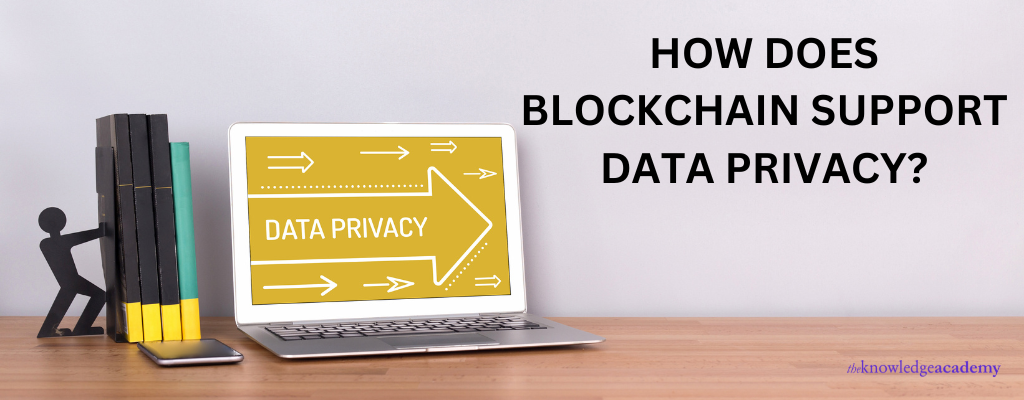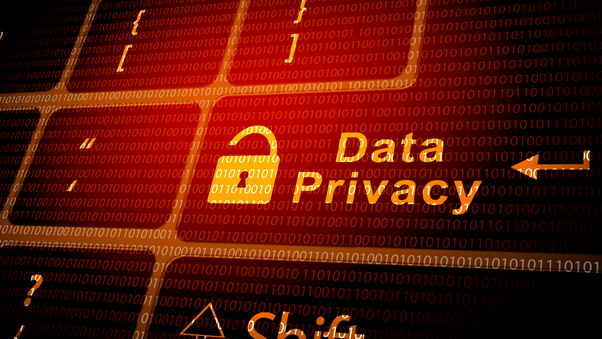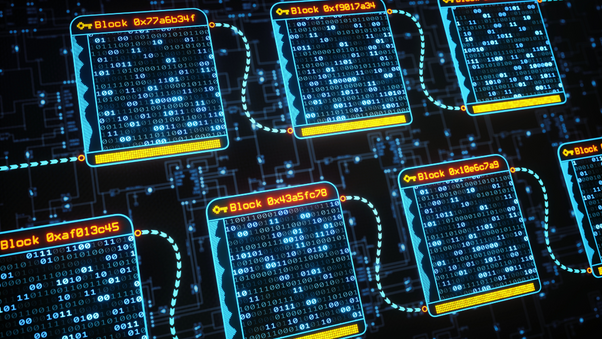We may not have the course you’re looking for. If you enquire or give us a call on 01344203999 and speak to our training experts, we may still be able to help with your training requirements.
Training Outcomes Within Your Budget!
We ensure quality, budget-alignment, and timely delivery by our expert instructors.

Blockchain, introduced in 2008, is defined as a shared, immutable ledger which helps facilitate the process of recording transactions and tracking assets. A record of transactions can be seen in real time by the users in a Blockchain network.
Today online privacy is a significant concern. More than 81% of users state the potential risks from companies that collect their data are more than the benefits. Companies have access to a wide array of personal information about the people who access their website, buy a product from them, or even enquire about a product. Many organisations have also been found to be selling user data.
The demand for protecting users’ data on the internet is increasing rapidly. Due to its decentralised nature and features, such as the focus on security, Blockchain is paving the way for ensuring online privacy. Widespread adoption of Blockchain technology to improve users’ personal information and its ownership is being advocated all around. Blockchain technology can change how personal information is gathered, stored, and accessed on the internet and protect it.
This blog covers the following to help you understand how Blockchain technology supports data privacy.
Table of Contents
1) Trends in Data Privacy Laws
2) Challenges in Data Privacy and Protection
3) How does Blockchain support Data Privacy?
4) Conclusion
Want to learn Blockchain? Join Blockchain Training Course – today!
Trends in Data Privacy Laws

Protecting the personal information of users is one of the essential concepts in the modern age of the internet. The number of regulations continues to grow at a rapid rate all around the world. Organisations are focusing on meeting the challenges of protecting the users' personal data and meeting regulatory requirements. Gartner predicts the annual budget for privacy and data protection will surpass £2 million annually by 2024.
Here are a few recent trends in data privacy laws.
Demand for more control over their data by the users – As computers and the internet continues to play a central role in people's lives, the need for more control over personal information is rising. Consumers are depicting such behaviour where they are choosing to align with companies that have transparent, honest, and stricter policies for collecting and using personal information.
Laws similar to the General Data Protection Regulation (GDPR) - The GDPR was launched in 2016. The launch of the GDPR has sparked a race among governments of several countries to either adopt or develop their legislation for a more concrete regulation of data protection. Countries have either adopted the GDPR or are developing legislation similar to the GDPR. It has become the benchmark in terms of handling personal information. While the GDPR is applicable in the European Union (EU), the House Energy and Commerce Committee of the United States voted to pass the federal American Data and Privacy Protection Act (ADPPA). This bill focuses on the way consumer data is gathered and stored. It is expected to be passed in Congress when it reconvenes in 2023.
Role of Artificial Intelligence (AI) and Machine Learning (ML) – Data protection has become a key concern for governments and organisations worldwide. The emergence of AI and ML has become both a boon and a danger regarding information security to users. Governments have already started focusing on developing legislation to limit the role and involvement of AI. However, it is expected that by 2023 AI and ML will be used to identify and stop cyber threats. As these technologies continue to improve, their role and impact on protecting users' personal information will also significantly increase. Blockchain technology, along with AI and ML, can revolutionise the way users' personal data is protected.
Become an expert Certified UR General Data Protection Regulation (EU GDPR) Practitioner course.
Challenges in Data Privacy and Protection

Following are some of the challenges associated with the difficulties regarding protecting the users' personal information.
Exponential Growth of Data – In recent years, the amount of data has grown at a significant pace. Every day, more than 2.5 Quintillion Bytes of data are created. It has become imperative for companies to focus on increasing the measures and policies put in place to protect consumers' sensitive personal information. Managing and securing this much data is complex and requires strict policy measures from organisations and governments across the globe.
Increasing Maintenance Costs – As the amount of data generated daily is growing fast, the cost of maintaining measures for protecting users' personal information is also snowballing. A single incident of a breach can cost company millions in lost revenue. Data breach in 2020 costed companies 38% of their total business, while the total cost of a breach increased on an average of 10 year-on-year.
Facial Recognition – It has become a means for people to log in to their systems and phones. This technology is being widely accepted and adopted. However, the number of people wanting to stay "off the grid" is also increasing as they have serious concerns regarding protecting their personal information. People often wear LED-lined glasses, masks, and bandanas to avoid detection by such technology and systems. This has become a cause of concern among many governments because people are using such approaches in protests. This makes it hard for law enforcement agencies to find culprits if any disturbance is created. However, considering the increasing concern among the citizens for the safety of their data, the San Francisco government has already banned the city's use of facial recognition software.
Join Personal Data Protection Bill Training course to understand the processing of personal data.
How does Blockchain support Data Privacy?

Blockchain is the digital database system where all transactions occurring on a peer-to-peer network are recorded. Using this technology, personal information can be stored in a decentralised manner, meaning no single authority will have full access and control over the information and transactions. These will occur directly between the end users (the recipient and the sender).
Blockchain technology gives ownership of information back to its users, making it safe and private. Since there is a layer of transparency and complete control, it further increases the feeling of safety and trust among the users. Here are some ways Blockchain supports the protection of users' data.
Preparing for an interview? Refer to these Blockchain Interview Questions and Answers to boost your preparation.
Decentralised Identity (DID)
Blockchain advocates have stated that individuals' identities should be controlled only by them. They should have complete autonomy on how different aspects of their identity are shared with others over the internet. Decentralisation is one of the critical aspects that help maintain Blockchain's security.
Decentralised identity developed on Blockchain networks is a way of managing one's identity online. It enables people to create their own digital identity, eliminating the dependency on the specific service provider. Digital identity consists of user names and passwords, search history, social security number, purchase history, and many more.
As Blockchain is essentially a distributed, decentralised ledger, it enables DID, resulting in which individuals can store their personal information independent of the databases of the websites they interact with. They can keep such information on their devices, such as PCs, mobile phones, hard disks, and cloud storage. Additionally, pointers to such information, known as 'Metadata', can be stored on the Blockchain.
Organisations and websites can then use this metadata to authenticate claims made by users regarding their personal information. Individuals can also create multiple DIDs for different purposes; only the person with the valid key can access and use the stored data. By using DID on the Blockchain, the users, to a great extent, can safeguard and protect their personal information on the internet.
Become a Certified Data Protection Officer (CDPO) today.
Validation and Encryption
Due to Blockchain systems tampering with information on the network is very difficult. Users can store documents or metadata of the file on the Blockchain. Using such technology, the users can ensure that their file has not been altered or modified. As the Blockchains have a decentralised structure, users can cross-check the file signatures and status on all the devices, ensuring that the file has not been changed. If any change is recorded, then the signature becomes void. Through Blockchain, users can guarantee the authenticity of the information independently.
51% Attack
A hacker needs to control 51% of the Blockchain to alter the records and information stored in the Blockchain network. But, gaining such control requires significant investment in money and other resources on the part of the hacker. Such individuals can attempt to add blocks to the Blockchain network by solving different complex mathematical problems by using computers with a process called 'Proof of Work'. If the hacker successfully adds a block, they can gain access to the information stored in the Blockchain.
Want to reach the highest position in information security? Join Chief Information Security Officer Training course.
Conclusion
Data privacy has become a hot topic, as the cases of personal and sensitive information of people being sold and accessed by companies for their profits are increasing. The GDPR and other such legislations are an example of efforts towards protecting the privacy of the users' data. However, they are very slow and complicated. Blockchain has emerged as a saviour and a step in the right direction for data privacy by decentralising the data and making it less accessible. Blockchain can help safeguard the data through its features, such as DID and processes for validation and encryption. With this blog, we hope you were able to understand ways in which Blockchain supports Data Privacy.
Frequently Asked Questions
Upcoming IT Security & Data Protection Resources Batches & Dates
Date
 Blockchain Training Course
Blockchain Training Course
Thu 11th Jul 2024
Thu 19th Dec 2024







 Top Rated Course
Top Rated Course



 If you wish to make any changes to your course, please
If you wish to make any changes to your course, please


